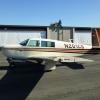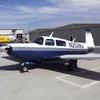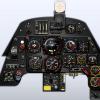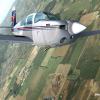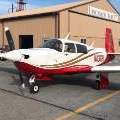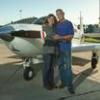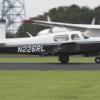Leaderboard
Popular Content
Showing content with the highest reputation on 12/19/2013 in all areas
-
Thanks to a forum member I may have finally found my ride. Seller has sent loads of hi res pics and about 40 logbook scans. Everything looks real good. Taking a 15 hour drive (one way) for Xmas tire kicking!3 points
-
The card is recognized by the PC. I went to Control Panel and Jepp shows up under the USB where it is plugged in. Got a PM from another MooneySpace member and I need a new subscription. That is probably the problem as the WAAS data card is different and with my current subscription it won't recognize the card.2 points
-
I did my phuysical 2 yeara agoa and did not need this but I'll need it next month. AOPA efforts while made with good intentions do fall short. I am sending the sponsoring representative a letter asking him to include IFR in the exemption. This is a fight that if it is won will not be revisited for a long time (5 years) and we need to fight for everything up front. The bill will need to traverse the aviation subcommittee and the transportation committee before seeing the light of day in the full house which presents 3 opportunities for the FAA to try and kill it and finally if it makes those hurdles you still have the Senate which may amend it and then the pres. would need to sing it and you wonder why the gov’t can’t do anything.2 points
-
Passing the physical tips: For those with high blood pressure, a glass of Merlot before the physical usually does the trick. For those with a bit of sugar, a test tube of your pets urine , later poured in the cup, usually does the trick. (Very few dogs are diabetic) For those who can't see the chart, cataract surgery is now an eight minute procedure. To pass the FAA polygraph, going into effect soon and administered by the NSA, lots and lots of Valium. Keeps all voltages low and all lines straight. For those who are asked to cough, I can't help you.2 points
-
I am a Board Certified Internist and Senior AME (Class I, II and III) in the Boston, MA area. I always as pilots to do the MedXpress form before coming in, print the form and bring the certification number. If they do not print it out, I can still look at it on line with them. There is a provision for me to change information entered on the form but only with the pilot's permission, knowledge and authorization. I must certify that I have those consents to alter any of the pilot's answers. If I can help provide any answers feel free to e-mail me at johnabreda@yahoo.com I do my exams in the Concord, MA area. Thanks, John Breda2 points
-
Probably more than what you wanted to know about fuel, but really explains where we are and where we are going. Pg. 3 http://www.iac38.org/newsletter/Jul2011NLhigh.pdf2 points
-
And DON'T give him/her the number unless you are certain you don't have any medical issues. Once the number is provided, you lose your chance at the LS if you do have a disqualifying condition. Hopefully the driver license medical stuff will go through and end this madness for us non-commercial folks.2 points
-
When filling out the form, if there is something you are not sure about, leave it blank or ask the Dr. about it when you see them. They can add items but I don't know if they can change items. You'd hate to answer something wrong and not be able to get it corrected. Bob2 points
-
I saw this topic and couldn't resist commenting. I've been in the market for a Mooney for several months now... the incredibly frustrating experience is worth another thread in itself (I commented a while ago about being called a "tire kicker" because I had the temerity to ask the seller what the asking price was.... sigh... Anyway, I had heard that you should buy the best plane you can afford, along the lines of (paraphrased) "an inexpensive plane costs about $90k and an expensive one costs about $60k"... I struggled with that concept of paying more up front, but kept getting uncomfortable with hidden costs like cam spalling and so on... It would be a bummer to pay top buck for what appeared to be close to perfect and then have to shell out another $40K. (things are a LOT more expensive in Canada) I decided that I would pay less upfront for a plane that had less than pristine maintenance but had "good bones", much as how I look at a house to purchase. I knew I would spend 30-40% of the purchase price doing ALL the things I would have done myself, but would at least know better my starting point. On Friday we start an in-depth prepurchase on an American M20J with a low time roller cam engine and quite good avionics (and damage history). Time will tell.2 points
-
Matt, let me put a plug in to have Don Maxwell's guys do a prebuy on it. GGG is not far from lower Alabama. I have recently worked with a gent who purchased a J from the N.O. area. The Maxwell prebuy/annual saved him many times over the cost of Don's work.1 point
-
My girlfriend says, "lets GO! We'll get a room on the beach for a few nights AND check out the Mooney." Room booked. Happy Xmas!1 point
-
1 point
-
If you're getting the G500, then having the second GPS IS worthwhile, since if the 1st one goes out the second one will feed the G500 in its place. If spending this much money on a new panel, I would go ALL IN and get EVERYTHING you could possibly want $$$ be damned.1 point
-
I always use take off flaps on my C. So far it has never failed to take off. In fact, I would say it has taken off almost as good as this thread.1 point
-
I have really come to love the ipad - Mine did however overheat once when it was left in a sunny part of the cockpit on a hot day and lower level flight - we never made it to cool air. So it shut off for heat, and i put it on the floor behind the co-pilot seat in the shade, and gave it about 20 minutes, it was fine after that. I've determined for that reason that my next ipad - the Ipad mini retna, that I'll get sometime in 2014, will be a white one, to help ensure it reflects vs absorbs heat (I have a blakc one now). -Seth1 point
-
Every two years is too soon. Seems like I just took the physical. High hopes for the DL program to pass. My doc charges $125.00 for 3rd class. It would be money in the bank or for Avgas if it passes1 point
-
1 point
-
Try Aero Motors LLC: http://www.aeromotorsllc.com They just overhauled our Dukes boost pump for $400. We paid for shipping both ways to Wisconsin. They had it back in the mail to us within 3 days of arrival at their shop. Bob1 point
-
1 point
-
It is ok to run the tanis/reiff 24/7 given you have foam cowl plugs installed. A blanket over the cowl is also very effective and raises temps even higher. By installing cowl plugs (and closing the cowl flaps) the cowl air surrounding the engine is warm and the dew point is moved outside of the engine. If a engine has been sitting plugged in try removing a cowl plug and feel how warm the air is inside the cowl. Warm Dry Air. If you leave the preheat device on with out cowl plugs the air side the cowl is closer to ambient and the dew point is moved either into the engine or somewhere close to it. If it ends up being inside the engine moisture can cause rust. In fact I can prove it. My plane is plugged in right now and my last Blackstone oil analysis have shown ZERO moisture content. In fact I believe it actually dries the engine out as if the air is 60 or so around the engine and the engine is 70 there is a heck of a spread in dew point. now move the temps down without leaving it plugged in and the dew point gets lot closer, plus if there is any moisture left in the engine from operation it doesn't dry out!!!!......it pays to leave your engine plugged in with cowl plugs installed 24/7, even if your not going to fly it. Anyone that says that operating a engine heater 24/7 with cowl plugs installed, will promote moisture inside of the engine is full of baloney.1 point
-
This is getting to be like MAPA....same threads over and over again. There is a search bar in the upper right corner of the home page. Topic suggestion........"Pushing a plane by the prop" (talk amongst yourselves).......Yawn........1 point
-
The tail on my Mooney is painted red. It is the only proper color for a Mooney tail. Anybody who is flying with a tail that isn't red isn't doing it right and is putting themselves in danger......1 point
-
Lets widen the discussion out a bit, and some or none of this may help, but hey it might be finn all the same. Slick Vs Bendix, well, you know the saying, "I would rather have timed out Bendix than a new slick!" But all jokes aside, there is not likely to be an issue there. However, my reason for asking about changes in EGT and CHT after the changes, is because the magneto timing and the internal timing of a magnet matter. A retarded timing setup will be less desirable when trying to run LOP, however you do not want excessive advance especially in a turbo. What I would be checking is that the timing is accurately set, and just because the A&P says so is not in my experience good enough. Buy your own or buy it for your mechanic if he does not have one. http://www.ritesystem.net How about a check list and every item is worth checking carefully. 1. Timing is actually as required…..double check! 2. Spark Plugs, gapped to 0.016-0.018" and check for resistance under 5000ohms. 3. Turbo owners, think carefully about replacing any Champion fine wires with either Champion or Tempest massive electrodes, or Tempest Fin Wires. 4. Ensure all plug wires and contacts are clean and in good condition. 4. Ensure all intake plumbing is leak free. This is very important, and even more so for NA engines and Lycomings are known to leak like a sieve!! 5. then if you can go the GAMI route. And follow the path of getting the F/A ratio's correct. 6. Often getting a RPM that works for you is trial and error, and even the N/A engines suffer this a little. 2400-2500 often works although personally I do not have a lot of experience with all the Turbo Lycomings, but some I have flown are no trouble at all. 7. If TIT is an issue check timing! Often a lower RPM helps, and if you get set up at say 29"/2400 and 80dF LOP, add back some MP of a couple of inches afterwards. 8. If you are going to run ROP, do so Rich enough!! The Red Box Green Box is summarised as follows; Red Box = No Fly Zone • At and below about 60% power, there is no red box. Put the mixture wherever you want it. • At about 65% power or so, 100ºF ROP to Peak. • At about 70%, 125ºF ROP to 25ºF LOP. • At about 75%, 180ºF ROP to 40ºF LOP. • At about 80%, 200ºF ROP to 60ºF LOP. Outside the Box • At 65% power, use richer than 100 ROP, or leaner than peak EGT. • At 70%, use richer than 125ºF ROP, or leaner than 25ºF LOP. • At 75%, use richer than 180ºF ROP, or leaner than 40ºF LOP. • At 80%, use richer than 200ºF ROP, or leaner than 60ºF LOP. Don, that is an interesting observation you have made. We firmly believe that the future with upcoming unleaded Avgas will be brighter for GA. There are a lot of people who are sitting on their hands and this is part of the slow down. Until there is confidence that the higher HP and Turbo aircraft have a fuel for the future, growth will naturally be negative. I can assure you that the future in respect of fuel is very bright indeed. The good thing is that if you are seeing growth, Mooney are going to produce again, Piper are going OK, Cirrus are selling, Beech could do well if they just got their act together……there is half a chance! Don I appreciate the accolades for the APS classes, you are 100% correct in that as pilots or engineers there is a huge gap in education and what is education is half wrong! Keep promoting it, I have no vested interest in the USA apart from the fact the course is something I am passionate about. Any Mooney owners down under, well you can keep your eye out for the next one we run down here! Any questions……keep 'em coming.1 point
-
My dad told me 1. Rest your weight on your elbows and 2. The gentleman always finishes last. Those are truisms I can live with. Flaps on takeoff...not so much.1 point
-
Bad acid flashback. Fantom- for the record, we had our own beds... Just so happened you share a room....1 point
-
Here's my advice. Since you're never gonna use the darned thing except in an emergency, don't get anything fancy. The most important thing in my mind is the ability to take AA batteries. I have a Vertex handheld that goes unused for a year at a time. Then when I want it, turns out the rechargeable battery is dead. I had this happen where from disuse it killed the battery and it would not recharge any more. So when I bought a new rechargeable battery for it, I also bought a AA adapter. Now I keep those 10+ year Lithium AAs in that pack and I always have some kind of spare AAs around.1 point
-
I cant think of anyone, but having it down to replace cylinders before TBO because of consistent running with high ICP's is a real slow way to fly. Not saying properly run ROP will cause this, but improperly run sure will. Ill run mine LOP high with a tail wind every time. With a stout headwind, Ill go lower and run ROP 125. I set with fuel flow now vs actual temps. Its not about the fuel savings or the speed, its about the CHT's and exhaust valve life for me. YMMV1 point
-
Well guys, I'm not quite as dumb as you may think. I have done a lot research to know what I'm looking for and what I'm looking at. I ask LOTS of questions of experienced owners, pilots, mechanics, and inspectors that I'm acquainted with and I pay attention. I consider this forum only one of a great bunch of resources at my disposal. I'm able and willing to work on a project airplane and so actually looking at substandard stuff is required. It can be one way to get a killer deal and I like killer deals. Yeah, it was a long drive but actually, I thoroughly enjoyed it because I got to spend hours with one of my favorite pals. When we weren't talking flying it was music, women, books... We never got bored! For me it was a 2 day vacation. It's just mind boggling to me that knowing how far I was traveling, the seller would so seriously misrepresent and make us wait around so much. If I hadn't had such a great time and learned so much I would have been incensed! One of the reasons I had such a good time was that while waiting for the seller my pal and I visited a local aviation museum on the field. While touring through hangers with a volunteer guide we came to what was described as a replica Jenny. Then my pal spoke up and said, "no, I built that airplane". The tour guide said, "you mean you built one of this type?" "No, I built THIS airplane. Actually, I DESIGNED and built this airplane when I was 18". The guide and I just stood there with out mouths hanging open not knowing what to say. Turned out that my buddy had sold this plane 30 years ago! It was the second (of over 20) that he built. Until we saw it there languishing in the dusty museum hanger he'd had no idea what had become of it. It was a pretty amazing moment and we knew right there that the entire trip was worth it.1 point
-
1 point
-
Now the real story about lubrication of valves: - Old engines (before the 70's) used stellite valve seats, this is a high carbon steel. This steel has a ferritic crystal structure is magnetic and sensitive to decarbonization by high temperatures, this is making this material softer. - Lead (TEL) does suppress this tendency at higher temperatures, so protecting the valve seats from becoming softer and causing negative valve clearance in engines without hydraulic valve clearance adjusters. This causes burnt valves (remember running an old beetle on unleaded gas will cause burnt valves). - When unleaded fuel was introduced in the 70's, the problem of the valve seats was solved by using an steel alloy with an austenitic crystal structure. This material is not magnetic and has very good high temperature properties, but it is more expensive. All automotive engines have this valve material as of the end of the 70's and as far is my knowledge is all certified aircraft engines have it even earlier, because it makes the engines much more reliable. - Valves were already earlier made from better materials because of the high mechanical load at high temperatures, especially the exhaust valves. You don't want a valve to break ever. So before improving the stellite crystal structured steel valve seats the valves were already made from a steel alloy with chromium, vanadium, tungsten to make them strong at high temperatures and resistant to softening by high temperature decarbonization. - Aviation engines don't need TEL for valve lubrication or valve seat scavenging. The only reason for TEL is Motor Octane Number (MON) period. So if there is a fuel with a sufficient MON leaded or unleaded it is suited for aircraft engines. Unfortunately at this moment TEL is the one of the most effective octane boosters. Otherwise we would have had already an alternative for the Leaded 100LL. I tried to run my turbo normalized IO360 engine on premium unleaded but saw after only a minute with a leaned engine that nr 2 CHT went up dramatically. Switching to the other tank with 100LL solved the nr 2 high CHT immediately. This process could be repeated by switching from one tank to the other. I did not test blends because this is for my a risk of not getting the ratio when filling the tanks. So I decided to stick to 100LL , proving that Lycoming is right about the statement that the angled valve head engines like the 200 HP IO360 are not suitable for unleaded Mogas. regards, Blue Eagle1 point
-
IMHO a battery should be replaced when you note a difference in the cranking speed of the engine, or you come out one morning and it won't turn the engine over. Naturally you have to have a point of reference to know about cranking speed. When I bought my plane, it was always hard to start. Eventually the battery completely died. When I replaced it, the cranking speed was substantially better. I was mad at myself for not changing sooner, but I just didn't know.1 point



